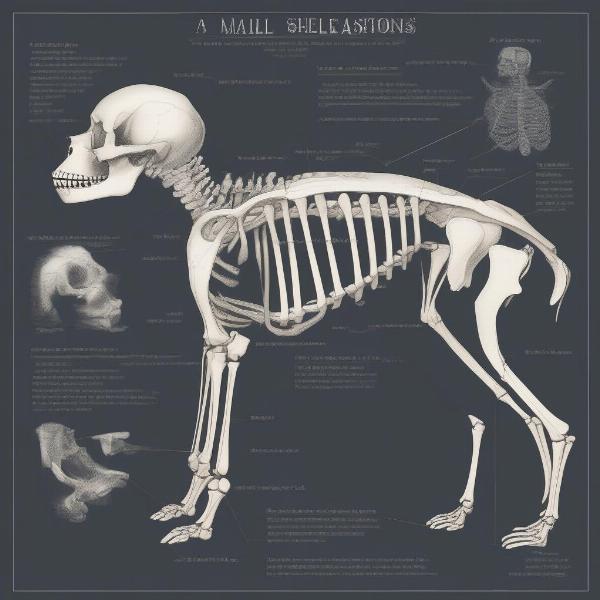The skeletal structure of a small dog, while seemingly delicate, is a marvel of biological engineering. Understanding the “small dog skeleton” is crucial for responsible pet ownership, informing everything from choosing appropriate exercise to recognizing potential health issues. This article delves into the intricacies of the small dog skeleton, highlighting key differences compared to larger breeds and offering practical advice for maintaining their bone health throughout their lives.
 Small Dog Skeleton Diagram
Small Dog Skeleton Diagram
Small dogs, by definition, have smaller bones than their larger counterparts. This seemingly simple fact has significant implications for their overall health and wellbeing. Their compact frames often mean they are more prone to certain skeletal issues, such as fractures and luxating patellas. Knowing the specifics of their skeletal structure allows owners to provide the appropriate care and minimize risks.
Key Differences in Small Dog Skeletons
While the basic skeletal blueprint remains consistent across all canine breeds, subtle variations exist in small dogs. These differences contribute to their unique physical characteristics and predispositions.
Skull Shape and Size
Small dog breeds often exhibit brachycephaly, characterized by a shortened skull and muzzle. While adorable, this trait can lead to breathing problems and dental issues. Other breeds may have a dolichocephalic skull, meaning a longer, narrower shape, which can be associated with different health concerns.
Bone Density and Structure
Smaller bones generally mean lower bone density, increasing the risk of fractures. This is particularly crucial to understand during puppyhood, when bones are still developing. Appropriate exercise and nutrition are vital during this stage.
Joint Health
Small dogs are particularly susceptible to luxating patellas, a condition where the kneecap dislocates from its normal position. This can be due to a combination of genetic predisposition and environmental factors.
Maintaining Bone Health in Small Dogs
Maintaining healthy bones in small dogs requires a proactive approach. Consider the following:
- Balanced Diet: Provide a high-quality diet formulated for small breeds, ensuring adequate calcium and phosphorus intake.
- Appropriate Exercise: Regular, low-impact exercise is essential, but avoid high-impact activities that could stress their delicate joints.
- Weight Management: Obesity puts extra strain on the skeleton. Maintaining a healthy weight is crucial for joint health and overall wellbeing.
- Regular Veterinary Checkups: Early detection of skeletal issues is vital for effective treatment.
Conclusion
Understanding the “small dog skeleton” is not just about anatomy; it’s about providing the best possible care for your beloved companion. By being aware of the unique characteristics and potential vulnerabilities of small breed skeletons, owners can make informed decisions about diet, exercise, and overall care, contributing to a long, healthy, and happy life for their furry friends.
FAQ
- What is the most common skeletal problem in small dogs? Luxating patellas and fractures are among the most common skeletal problems.
- How can I prevent my small dog from developing bone problems? A balanced diet, appropriate exercise, and weight management are key.
- What are the signs of a skeletal problem in my small dog? Limping, lameness, stiffness, and difficulty moving are potential signs.
- Are certain small breeds more prone to skeletal issues than others? Yes, some breeds are genetically predisposed to specific conditions.
- What type of exercise is best for a small dog with joint problems? Low-impact activities like swimming and short walks are generally recommended.
- How often should I take my small dog to the vet for checkups? Annual checkups are generally recommended, but more frequent visits may be necessary for senior dogs or those with existing health conditions.
- Is special bedding recommended for small dogs with joint pain? Orthopedic beds can provide extra support and comfort for dogs with joint pain.
ILM Dog is your trusted source for expert advice on all aspects of dog care, from breed selection to senior care. We offer practical, evidence-based information to help you navigate the joys and challenges of dog ownership. Whether you’re a new dog parent or a seasoned expert, we’re here to help you give your furry friend the best life possible. Contact us today for personalized guidance and support: Email: [email protected], Phone: +44 20-3965-8624. ILM Dog is dedicated to helping you build a stronger bond with your canine companion.